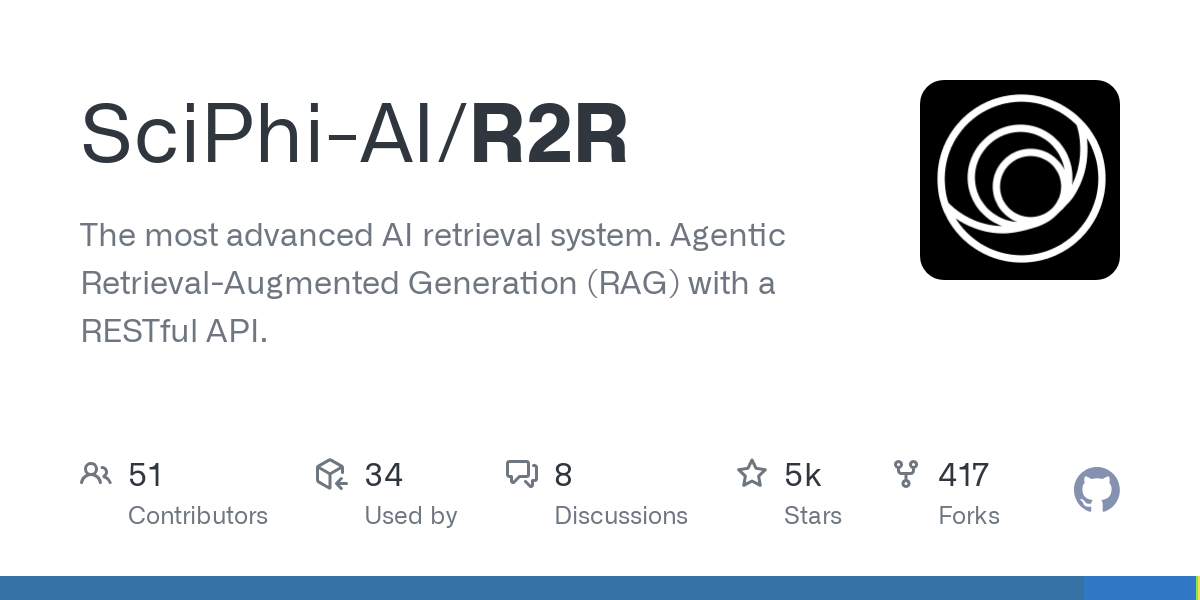Table of Contents
Overview
In today’s data-rich environment, finding the right information quickly and reliably is paramount. Enter R2R, an open-source agentic retrieval system developed by SciPhi-AI, designed to autonomously process documents and web data, build knowledge graphs, and deliver citation-backed answers via RESTful APIs. This powerful tool promises to revolutionize how we access and utilize information, but is it the right solution for your needs? Let’s dive in and explore its features, functionalities, and potential drawbacks.
Key Features
R2R boasts a compelling set of features that make it a strong contender in the AI-powered information retrieval space:
- Agentic retrieval via API: Access information through a powerful and flexible API, allowing for seamless integration with existing systems and workflows.
- Autonomous document processing: R2R can automatically ingest and process various document types, extracting key information without manual intervention.
- Web scraping: Gather data directly from the web, expanding your knowledge base beyond internal documents.
- Knowledge graph construction: Structure extracted information into a knowledge graph, enabling deeper insights and more complex queries.
- Citation-backed responses: Ensure the accuracy and reliability of information with responses that are supported by verifiable citations.
How It Works
R2R operates as an intelligent agent, autonomously navigating the complexities of information retrieval. It integrates multiple AI modules to retrieve, analyze, and synthesize information from both documents and the web. The process involves automatically extracting key entities, relationships, and facts from diverse data sources. These insights are then structured into a knowledge graph, which serves as the foundation for answering queries. Finally, R2R provides access to this structured knowledge through API endpoints, allowing developers to easily integrate its capabilities into their applications.
Use Cases
R2R’s capabilities make it a versatile tool for a variety of applications:
- Enterprise knowledge management: Centralize and streamline access to internal knowledge, improving employee productivity and decision-making.
- Research assistance: Accelerate research by automating the process of gathering and synthesizing information from diverse sources.
- Legal and compliance automation: Automate legal research, contract review, and compliance monitoring, reducing costs and improving accuracy.
- Academic research support: Provide researchers with a powerful tool for exploring complex topics and uncovering new insights.
Pros & Cons
Like any tool, R2R has its strengths and weaknesses. Understanding these will help you determine if it’s the right fit for your specific needs.
Advantages
- Open-source and customizable: Offers complete control and flexibility to tailor the system to specific requirements.
- Supports multiple data types: Handles a wide range of document formats and web data, providing comprehensive coverage.
- Strong API integration: Enables seamless integration with existing systems and workflows.
Disadvantages
- Requires setup and hosting expertise: Setting up and maintaining R2R requires technical expertise in AI and infrastructure.
- Limited documentation: The current documentation may not be sufficient for all users, potentially increasing the learning curve.
How Does It Compare?
When evaluating R2R, it’s important to consider its competitors.
- ChatGPT + Retrieval Plugin: Offers broader integration capabilities with other AI tools but may lack the specialized knowledge graph construction of R2R.
- Haystack: Provides stronger enterprise support and features but may not offer the same level of customization as R2R.
Final Thoughts
R2R presents a compelling solution for organizations seeking to harness the power of AI for information retrieval. Its open-source nature, coupled with its ability to build knowledge graphs and provide citation-backed answers, makes it a powerful tool for a variety of use cases. However, the need for setup and hosting expertise, along with limited documentation, means that it may be best suited for organizations with strong technical capabilities. Ultimately, R2R offers a promising path toward more efficient and reliable information access.
